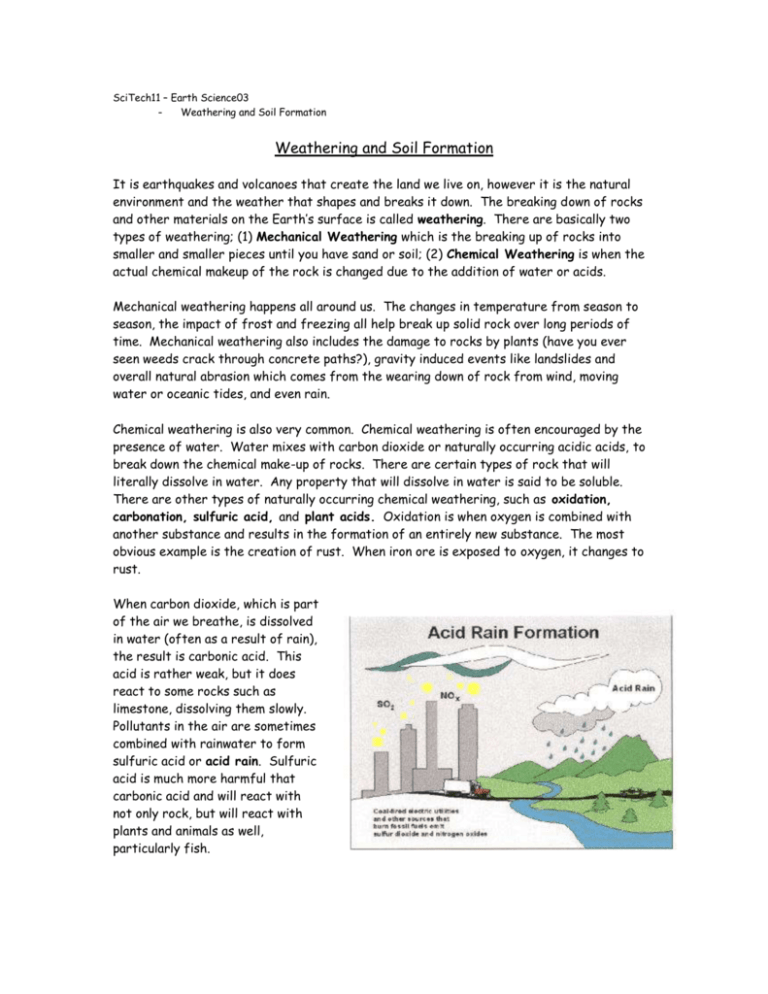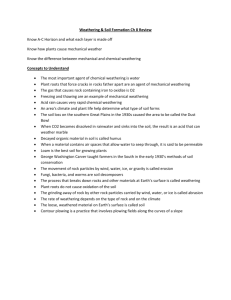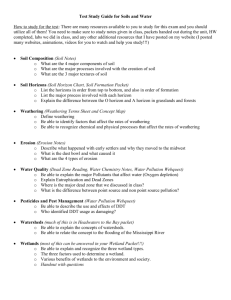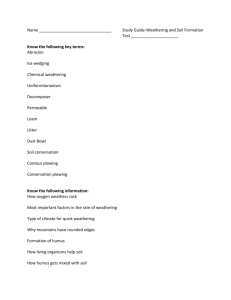Weathering and Soil Formation
advertisement

SciTech11 – Earth Science03 - Weathering and Soil Formation Weathering and Soil Formation It is earthquakes and volcanoes that create the land we live on, however it is the natural environment and the weather that shapes and breaks it down. The breaking down of rocks and other materials on the Earth’s surface is called weathering. There are basically two types of weathering; (1) Mechanical Weathering which is the breaking up of rocks into smaller and smaller pieces until you have sand or soil; (2) Chemical Weathering is when the actual chemical makeup of the rock is changed due to the addition of water or acids. Mechanical weathering happens all around us. The changes in temperature from season to season, the impact of frost and freezing all help break up solid rock over long periods of time. Mechanical weathering also includes the damage to rocks by plants (have you ever seen weeds crack through concrete paths?), gravity induced events like landslides and overall natural abrasion which comes from the wearing down of rock from wind, moving water or oceanic tides, and even rain. Chemical weathering is also very common. Chemical weathering is often encouraged by the presence of water. Water mixes with carbon dioxide or naturally occurring acidic acids, to break down the chemical make-up of rocks. There are certain types of rock that will literally dissolve in water. Any property that will dissolve in water is said to be soluble. There are other types of naturally occurring chemical weathering, such as oxidation, carbonation, sulfuric acid, and plant acids. Oxidation is when oxygen is combined with another substance and results in the formation of an entirely new substance. The most obvious example is the creation of rust. When iron ore is exposed to oxygen, it changes to rust. When carbon dioxide, which is part of the air we breathe, is dissolved in water (often as a result of rain), the result is carbonic acid. This acid is rather weak, but it does react to some rocks such as limestone, dissolving them slowly. Pollutants in the air are sometimes combined with rainwater to form sulfuric acid or acid rain. Sulfuric acid is much more harmful that carbonic acid and will react with not only rock, but will react with plants and animals as well, particularly fish. Plants themselves, such as mosses and lichens, produce their own weak acids, that over time contribute to the breaking down of rocks. Whether by plant, carbonic or sulfuric acids or by oxidation, chemical weathering plays a huge role in the breaking down of solid rock into smaller and smaller pieces until, eventually, soil is formed. The formation of soil is extremely important to most living organisms, both plant and animals in this world. The breaking up of rock into soil provides nutrients and a place for plants to grow. This in turn provides plant food for animals, which in turn provide food for other animals, and so on. Soil itself is often a combination of residual soil, transported soil and humus. Residual soil is the remains of the original parent rock that has been broken up from weathering. Transported soil, is soil that has been transported, either by wind or moving water to a new location. Humus is the dark-colored material that is often found on the upper most layer of the surface. Humus is a combination of soil and decaying plants and animals. The humus is the most important part of soil for plants. The decay of the Humus is often added by the movement of plants, animals and insects (moles and worms are good examples). The pieces of weathered rock and the organic material of the humus are the two main ingredients of soil. The specific composition of soil, however, varies from place to place, depending upon the particular make-up of parent rock, the variety of plant and animal life found there and the degree and particular types of weathering that occurs. The soil composition of the Pacific coast of British Columbia is often quite different from the soil composition of the dryer Interior. The amount of rainfall and the different degrees of plant life abundance all play a part. As soil forms, it develops separate soil layers called horizons. The horizons are divided into 3 different types, Type A Horizon, Type B Horizon and Type C Horizon, followed by the bottom bedrock. Type A Horizon soil is more commonly known as topsoil and is the most fertile part of the soil. This is due to the Humus component and the porous nature of the soil that allows for the holding of water and chemical nutrients that are absorbed by plants. The chemical nutrients that are washed further down into the soil, into the next level is called leaching. The leaching of material into Type B Horizon results in the next layer of soil being somewhat nourished. Type B Horizon is often referred to as the subsoil layer and this subsoil layer often takes upwards of 100,000 years to form. The third layer of soil is called Type C Horizon. The C Horizon consists of partly weathered rock. The C Horizon extends down to the top of the parent rock. All three layers are developed over long periods of time and are dependent upon the extent and type of weathering it has to endure. This is often why in more temperate climates, where there is an abundance of plant life and rain, the soil is often more fully developed and why drier regions such as a desert, often do not have as much layering. Soil composition and weathering occurs in many different forms, changing the immature molten rock from the core to the mature soil that supports life on this planet. SciTech11 – Earth Science03 - Weathering and Soil Formation Weathering and Soil Formation 1. Vocabulary – Use your readings, a dictionary, a textbook or an encyclopedia to provide definitions for the following terms; Mechanical Weathering Chemical Weathering Residual Soil Humus Topsoil Leaching Subsoil 2. Answer the following questions using COMPLETE SENTENCES; a. Using your own words, describe what “weathering” is. (2 mks for quality of response and inclusion of details) b. In your own words, describe how different types of acids get into the ground and rock and what these acids do to the ground and rock once they are there. (2 mks for quality of response and inclusion of details) c. Using your own words, describe how soil is formed. Be sure to describe the 3 distinct layers of soil. (2 mks for your description and inclusion of the three layers of soil) d. Provide an example as to how weathering is good for the planet and how weathering is bad. (2 mks for the quality of both of your examples) 3. Use the internet to access information on Acid Rain. Write a paragraph that defines what Acid Rain is, how it is formed, how it affects the environment and what should be done about it. Print out the web pages you used in your research and hand in with this assignment sheet and your answers. You will be marked out of 5 for your ability to access and interpret information related to Acid Rain. Total Marks: ___/ 20








